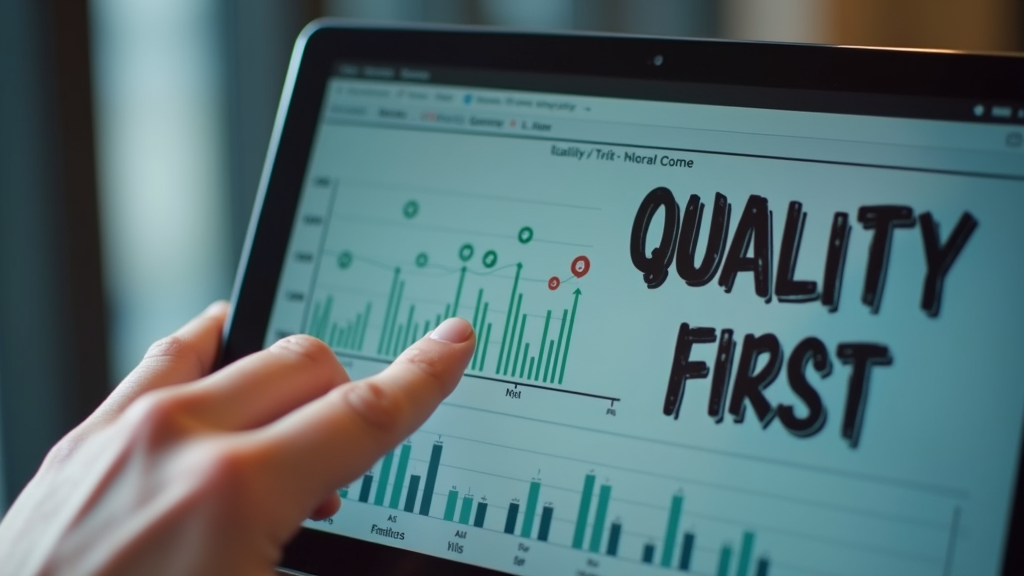
Introduction
Managing SEO takes up countless hours of your workday. Between keyword research, content optimization, and tracking rankings, you might feel like there aren't enough hours to get everything done. SEO automation tools can handle many repetitive tasks while you focus on growing your business.
You might worry that automating SEO could hurt your website's performance or lead to penalties from search engines. This is a valid concern, but modern SEO automation tools are built to work within search engine guidelines. They help you work smarter by handling routine tasks and giving you more time for strategic decisions. With the right approach, automation becomes your ally in achieving better search rankings while saving valuable time.
What Is SEO Automation
SEO automation uses software tools to handle repetitive SEO tasks automatically. Think of it as your digital assistant that takes care of routine SEO work while you focus on strategy and creative tasks. From checking your website's health to tracking your rankings, automation tools make SEO management simpler and more efficient.
The world of SEO automation has grown significantly over the years. What started as simple tools for checking broken links has evolved into smart systems powered by artificial intelligence. Today's SEO automation can analyze content quality, suggest improvements, and even help create SEO-friendly content. Tools like Semrush and Ahrefs now offer advanced features that were unimaginable just a few years ago.
Here's how SEO automation helps you:
- Time Savings: Cut hours of manual work down to minutes
- Consistency: Get reliable results without human error
- Scalability: Manage multiple websites or pages at once
- Data Accuracy: Generate precise reports automatically
- Early Problem Detection: Spot and fix SEO issues before they affect your rankings
- Regular Monitoring: Keep track of your SEO performance without constant manual checks
Tasks You Can Automate
SEO involves many repetitive tasks that eat up your time. Automation helps you focus on strategy while software handles the routine work.
Here are the SEO tasks you can automate:
1. Keyword Research
Your software can find new keyword opportunities and track their search volume automatically. It updates you when trends change or new keywords become relevant to your business.
2. Rank Tracking
Get daily updates about your website's position in search results without manual checking. The software monitors your rankings across different locations and devices.
3. Technical Audits
Automatic scans catch broken links, missing meta descriptions, and slow-loading pages. You'll know about technical problems before they hurt your rankings.
4. Content Optimization
Software can analyze your content and suggest improvements for readability and SEO. It checks keyword usage, headings, and meta tags to help you optimize faster.
5. Backlink Monitoring
Track new and lost backlinks automatically. You'll get alerts about harmful links and opportunities to build relationships with websites linking to you.
6. Automated SEO Reports
Generate detailed reports showing your progress without spending hours collecting data. Share them with your team or clients to show the value of your SEO work.
Tasks You Shouldn't Automate
While SEO automation helps with many tasks, some aspects need your personal attention. Your expertise and creativity bring unique value that no tool can replace. Understanding which tasks require human oversight will help you maintain high-quality SEO results.
Here are the key tasks that need human involvement:
1. Content Creation
Your content needs to connect with readers on a personal level. While AI can help with research and basic writing, you should oversee the creative process. This includes developing your brand voice, understanding your audience's needs, and crafting compelling stories that resonate with your readers.
2. Strategic Planning
Your business goals and market conditions are unique. You need to analyze data, spot trends, and make informed decisions about your SEO strategy. This includes choosing target keywords, identifying content opportunities, and adjusting your approach based on results.
3. Relationship Building
Building links and partnerships requires genuine human connections. You need to network with other website owners, create valuable partnerships, and maintain professional relationships. These interactions need your personal touch to be authentic and effective.
4. Quality Checks
Before publishing content or implementing changes, you should review everything carefully. This includes checking for accuracy, ensuring brand consistency, and verifying that automated tools haven't made mistakes. Your final approval matters for maintaining high standards.

Common Automation Pitfalls
SEO automation can backfire if you don't implement it carefully. While automation tools promise to save time and effort, many businesses rush into using them without proper planning or understanding. This often leads to costly mistakes and missed opportunities.
Here are the key pitfalls to watch out for:
- Poor tool selection: Choosing automation tools that don't match your business needs or integrate with your existing systems
- Over-automation: Letting machines handle tasks that need human oversight, like content creation or link building
- Lack of monitoring: Setting up automated processes without regular checks on their performance
- Ignoring data quality: Relying on automated data collection without verifying its accuracy
- Inconsistent settings: Using different automation rules across your website sections, creating confusion for search engines
- Missing manual reviews: Failing to personally check automated changes before they go live
Regular human oversight helps you spot these issues early. You should review your automation setup monthly and adjust your approach based on what's working best for your website.
Essential Automation Tools
Picking the right SEO workflow tools will save you hours of manual work each week. Your choice of automation tools can make a big difference in how quickly you can improve your website's rankings and track your progress.
Here's how basic and advanced automation tools compare:
| Feature | Basic Tools | Advanced Tools |
|---|---|---|
| Features | Simple keyword tracking, basic site audits, manual reporting | Full workflow automation, AI-powered suggestions, real-time rank tracking |
| Scalability | Good for single websites, limited data storage | Multiple websites, unlimited data storage, team collaboration |
| Ease of Use | Simple interface, quick setup | Learning curve, detailed settings |
| Integration | Limited third-party connections | Wide range of API connections, custom integrations |
Both types of tools can help your SEO efforts, but your choice should match your business size and goals. If you're just starting, basic tools will cover your needs. As your business grows, you might want to upgrade to advanced tools that offer more features and better scaling options.
Setting Up Your First Automation
Starting with SEO automation doesn't need to be complicated. You can begin with small steps that make a big difference in your daily work. Think of it like building with blocks one piece at a time.
1. Set Clear Goals
Write down what you want to achieve with automation. Pick one specific task to start with, such as tracking keyword rankings or monitoring backlinks.
2. Choose Your Tools
Select tools that match your goals. Look for software with good reviews and reliable customer support. Start with the basic version before upgrading to more advanced features.
3. Map Your Process
Write out each step of the task you want to automate. Include everything from data collection to report creation. This helps you spot opportunities for improvement.
4. Test Your Setup
Run a small test of your automation. Try it with a limited set of data first. Make adjustments based on what works and what doesn't.
5. Monitor Results
Keep an eye on how your automation performs. Check if it saves time and produces accurate results. Make improvements as needed.
Remember to give yourself time to learn. Your first automation might take a few tries to get right, but each attempt makes you better at spotting new opportunities to save time.

Quality Control Measures
You might worry that SEO automation could hurt your content quality. The good news is that with the right quality control measures, you can enjoy automation's benefits while keeping your SEO standards high.
A successful automated SEO strategy combines smart technology with human supervision. Your content still needs your expert touch to ensure it meets your brand's standards and connects with your audience. Regular checkpoints help you spot and fix any issues before they affect your rankings.
Here are the essential quality control steps for your automated SEO:
1. Set Clear Quality Benchmarks
Create specific guidelines for your content, including keyword density, readability scores, and link requirements. These benchmarks will guide both your automated tools and manual reviews.
2. Schedule Regular Automated SEO Audits
Run weekly or monthly automated audits to check your website's health. Look for technical issues like broken links, missing meta descriptions, or duplicate content that could harm your rankings.
3. Conduct Manual Content Reviews
Review a sample of your automated content regularly. Pay special attention to readability, tone, and how well it matches your brand voice. This helps you catch anything your automated tools might miss.
4. Track Performance Metrics
Monitor key metrics like organic traffic, rankings, and conversion rates. If you notice any unusual patterns, you can quickly adjust your automation settings or quality control process.
Integration With Existing Systems
Your SEO automation tools should work smoothly with your current marketing setup. You can connect your favorite tools like WordPress, Google Analytics, and Shopify without replacing your existing workflow. This means you'll spend less time switching between different platforms and more time growing your business.
Getting your tools to share information shouldn't give you headaches. Modern SEO automation platforms use simple API connections to keep your data flowing between systems. Your keyword rankings, content performance, and SEO metrics will update automatically across all your connected tools. This automatic synchronization helps you make better decisions about your content strategy while saving valuable time on manual data entry and updates.
Cost Benefit Analysis
Before investing in SEO automation tools, you need to know if they're worth your money. The main value comes from reducing repetitive tasks and freeing up time for creative work. Your current SEO expenses might include hiring writers, buying various tools, or spending your own valuable time on manual tasks.
Here's how manual and automated SEO approaches compare:
| Aspect | Manual SEO | Automated SEO |
|---|---|---|
| Time Investment | Several hours daily for research and updates | Quick setup with periodic monitoring |
| Cost | Lower upfront cost but more ongoing expenses | Higher initial investment with lower running costs |
| Scalability | Limited by available time and team size | Handles multiple projects simultaneously |
| Accuracy | Prone to human error during repetitive tasks | Consistent results with occasional tech issues |
The key to positive ROI lies in matching automation tools to your specific needs. Small businesses might benefit most from automating keyword research and rank tracking, while larger operations could automate their entire SEO workflow. Start with tools that address your biggest time drains, then expand as you see results.
Future of SEO Automation
SEO automation tools are becoming smarter and more capable every year. You'll see more tools using natural language processing to analyze content quality and user intent. These advances help you spend less time on technical SEO tasks and more time creating valuable content for your audience. Voice search optimization and mobile-first indexing are pushing automation tools to adapt, giving you better insights into how users actually find your content.
Artificial intelligence is changing how SEO automation works for your business. AI-powered tools can now spot patterns in your website data that humans might miss. This helps you understand which content performs best and why. Machine learning algorithms are getting better at predicting search trends and suggesting content topics that your audience wants to read. While AI won't replace human creativity in content creation, it will make your SEO efforts more effective by handling the data analysis and technical optimization automatically. You'll be able to focus on creating engaging content while automation handles the complex technical details behind the scenes.
FAQ
How much does SEO automation cost?
SEO automation tools vary widely in price based on your needs. Most providers offer monthly subscriptions that scale with your usage. The final cost depends on factors like the number of keywords you track, how many pages you monitor, and which features you need. Basic packages often include keyword tracking and simple automations, while premium options add advanced features like competitor analysis and content optimization.
Can small businesses benefit from SEO automation?
Yes, SEO automation works well for businesses of all sizes. You can start with basic features that fit your budget and expand as your business grows. Small businesses often see quick wins by automating simple tasks like keyword research and rank tracking. This lets you focus more time on creating great content and building relationships with customers.
Will automation replace SEO professionals?
No, automation won't replace SEO professionals. Think of automation as a helpful assistant that handles repetitive tasks. You still need human expertise to make strategic decisions, create engaging content, and understand your audience's needs. Automation enhances human work by providing data and insights faster, letting professionals focus on creative and strategic tasks that machines can't do well.
How long does it take to set up SEO automation?
Setting up basic SEO automation typically takes a few days to a week. The timeline varies based on your goals and technical experience. Simple tasks like keyword tracking can be running within hours. More complex automations, such as content optimization workflows, might need a few weeks to fine-tune. Most tools offer setup guides and support to help you get started quickly.
Your SEO efforts become more efficient with the right automation tools. Contly AI helps you automate keyword research and generate SEO-optimized articles while maintaining quality. This means you can create more content in less time without sacrificing the human touch that makes your content unique and valuable to your readers.
